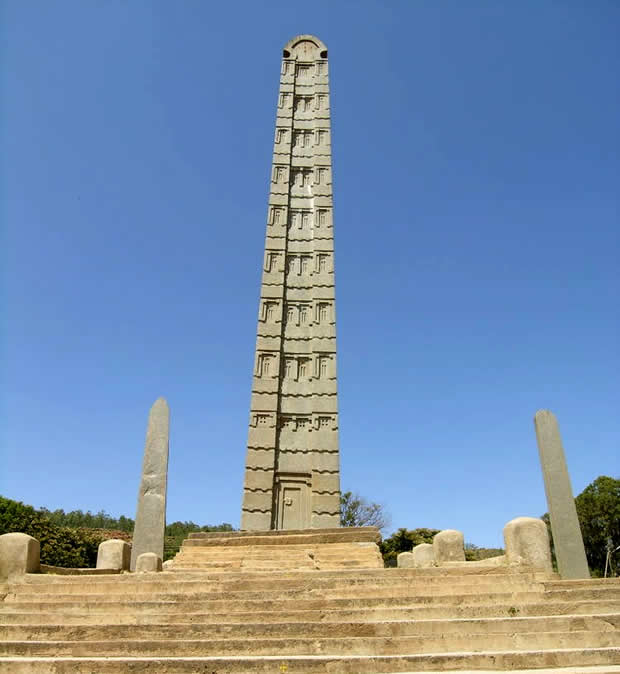 |
| stele in Axum |
Ethiopia’s unique and venerable identity stems from its claims to have deep roots in the ancient and biblical world. On one hand it continued the ancient civilization represented by Axum, the trading intermediary for Rome and India on the Red Sea.
And on the other hand, it promoted its mythical link to King Solomon by keeping a tenacious grip on its Christian (and even Jewish) faith all through the Muslim period, and its strong church-state hegemony gave teeth to its claims. The Christian king of late Axum, El-Asham, distinguished himself in Muslim memory by giving sanctuary to followers of the prophet Muhammad who were driven out of the city of Mecca in 615.
Nonetheless conflict broke out when Muslims from North Africa moved southward in the eighth century and cut off Ethiopia from the Christian world. For the next 900 years the history surrounding Ethiopia would be muted in its contact with the West, and outlines of its history hinted at through folklore and archaeology. Hemmed in, the kingdom of Axum spread to the south into the highlands. Here non-Semitic peoples resided, the Agaws of Cushitic ethnicity.
  |
For reasons unknown some had been previously touched by Jewish influences and called themselves Falashas, and others were Christians already or were converted gradually. The latter group merged with the Axum elites and eventually replaced the ruling house with the Zagwe dynasty. The Zagwes moved the capital 160 miles south to Roha.
According to tradition they were especially devout, and one of their more venerated emperors, Lalibela (1195–1225), directed the construction of 11 churches hewn out of solid rock. These churches served as a pilgrimage destination for believers when they could not overcome Muslim refusals to visit the Holy Land. The dynasty following the Zagwes in 1270 returned to the age-old tradition that their kings had descended from King Solomon.
Their epic tale, Kebre Negast (Glory of the Kings), speaks of their ancient ancestor and first king, Menelik I, being born of the queen of Sheba (Saba) and Solomon. The son Menelik returned to his native land with the Ark of the Covenant, having shrewdly taken it from his father. Ethiopians to this day believe that the Ark is present in their country. Its presence guarantees a biblical covenant with their nation.
The new Solomonids were proactive, cultivating their biblical image. They merged their role in government with the role of the clergy in the church, putting their sons into a monastery-like community on Mount Geshen so that they would pray and learn while they waited for their call to govern the nation.
Their reputation was one of priest-kings. By the mid-14th century they advanced against Muslims and pagans surrounding them. Their king, Amde-Siyon, was reported by one Arab historian, Al-Omari, to have a following of 100 kingdoms.
   |
Zar’a Ya’kob (1434–1468) achieved even greater status, aspiring to greatness by being crowned in ancient Axum. During his regime he developed new evangelistic campaigns to convert all subjects to the Christian faith. Church schools were opened up for priests, as well as ruling class students and seminarians. Ethiopian arts flourished, and these writings, artifacts, and murals still exist.
When Zar’a Ya’kob died the Muslims and outsiders rose up in rebellion. Sultan Ahmad Gran conducted a devastating jihad against the monasteries and churches (1527–43). Meanwhile for several centuries Europeans had heard reports of a legendary African emperor named Prester (“priest”) John who would help out Christian armies in the Crusades against the Muslims of the Near East and Africa. In hopes that Ethiopia was Prester John’s domain, 400 Portuguese troops were sent to put a stop to Sultan Ahmad Gran’s campaign against Ethiopia.
